feature image from theurbanemix.com
Freedom to Work, The Movement Advancement Project, The Center for American Progress, The Human Rights Campaign, and The National Black Justice Coalition came together to release a report entitled A Broken Bargain for LGBT Workers of Color [PDF] this week. The piece asserts that LGBT workers of color “are among the most disadvantaged workers in America.”
The basic American bargain is that people who work hard and meet their responsibilities should be able to get ahead. It is an agreement that workers will be judged and rewarded based on their contributions and capabilities—no matter who they are, what they look like, or where they are from. This basic bargain is not just an idea—it is embedded in laws that promote equal access to jobs and that protect workers from unfair practices.
For LGBT workers of color in America, this bargain is in tatters. Instead of having a fair chance to get ahead, LGBT workers of color often are held back by a combination of barriers that adversely affect their ability to get a quality education and find good, family-supporting jobs in workplaces that are free of discrimination. While it can be hard to identify exactly how the forces of bias and prejudice based on race, sexual orientation and gender identity intersect, the fact is that they do so to the detriment of LGBT workers of color, making them some of the most disadvantaged workers in the U.S. workforce.
The report is groundbreaking in both its approach and involvement: it’s the most in-depth study on LGBT workers completed to date and also applies an intersectional framework in a comprehensive, descriptive way. In just over 60 pages, it examines separately the challenges faced by LGBT people and communities of color and then seamlessly explains what they look like when they’re woven together. “The experiences of LGBT workers of color often do not exactly mirror the experiences of other workers of color,” the report explains, “just as they often do not mirror the experiences of white LGBT workers.”
For queer women of color, intersectionality isn’t just a “concept” or a “framework” for theorists to use for mind exercise — it’s a lived experience. But the common visualization of the experience often comes down to intersecting lines, thus oversimplifying the magnitude. Intersectionality is more like layers of sand than overlapping lines; often, the consequences of inequality don’t cross – they coexist and even feed one another. They aren’t visibly alien to one another, and it isn’t always possible to parse them out.
“It is no surprise that research finds that women, people of color and queer people face discrimination, harassment, and bias in the workplace,” Preston Mitchum, a policy analyst at the Center for American Progress, told me.”For individuals who stand at the intersection of race, sexual orientation, and gender identity, their risk of experiencing discrimination is exacerbated. Sexism, racism, homophobia, biphobia, and transphobia can lead to a precarious situation for queer women of color.”
“Only focusing on the race-based or sexual orientation/gender identity-based aspects of their work experience is too simplistic. They may experience discrimination exactly because they are queer, a woman, and a person of color.”
By presenting the effects of systemic and social inequties as interdependent, the report’s authors thus challenge us to see inequities as composed of varying elements (all of which are bubbling and fizzing out our human rights). “It is important in thinking about the experiences of queer women of color at work and in schools to keep a holistic picture of their experiences,” Mitchum said. “Only focusing on the race-based or sexual orientation/gender identity-based aspects of their work experience is too simplistic. They may experience discrimination exactly because they are queer, a woman, and a person of color.”
“Queer women of color experience the impacts of anti-gay and racist discrimination in the workplace in ways such as lack of promotions, lower wages, and a general distain for their existence,” Mary Hooks, Co-Campaign Coordinator for Southerners on New Ground (SONG) said to me in an email. “Navigating even the dress code of some workplace standards can be a struggle. The intersection of sex discrimination happens at all levels (not dressing in a particular way, not given leadership positions, quid pro quo offers, etc.) and often times it’s the assumption of behavior, that we don’t prescribe to, i.e. talking about your husband in the employee break room, that keep us from building relationships in the workplace.”
“The intersection of sex discrimination happens at all levels (not dressing in a particular way, not given leadership positions, quid pro quo offers, etc.) and often times it’s the assumption of behavior, that we don’t prescribe to, i.e. talking about your husband in the employee break room, that keep us from building relationships in the workplace.”
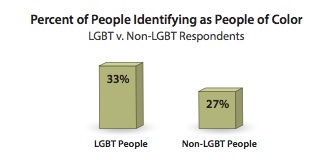 The authors of the report incidentally chose a strong example of these intersections by focusing on LGBT workers of color: their findings concluded that the LGBT community is more diverse than that of the national population (33% vs 27%) and is also constituted heavily by immigrant populations (over 904,000 adult immigrants are LGBT). Of 5.4 million LGBT workers in the United States, 1.8 million are people of color — and across the nation, LGBT people and/or people of color struggle with poverty at a higher rate than non-LGBT and/or white folks (black women in same-sex couples are more than three times as likely to be poor as white women in same-sex couples). These numbers reveal that it’s important that we “break out of silos,” as Mitchum told me, to find solutions to discrimination. And they make the elusive idea of implementing intersectional, holistic frameworks to our work toward ending discrimination against LGBT people imperative.
The authors of the report incidentally chose a strong example of these intersections by focusing on LGBT workers of color: their findings concluded that the LGBT community is more diverse than that of the national population (33% vs 27%) and is also constituted heavily by immigrant populations (over 904,000 adult immigrants are LGBT). Of 5.4 million LGBT workers in the United States, 1.8 million are people of color — and across the nation, LGBT people and/or people of color struggle with poverty at a higher rate than non-LGBT and/or white folks (black women in same-sex couples are more than three times as likely to be poor as white women in same-sex couples). These numbers reveal that it’s important that we “break out of silos,” as Mitchum told me, to find solutions to discrimination. And they make the elusive idea of implementing intersectional, holistic frameworks to our work toward ending discrimination against LGBT people imperative.
In an intersectional context, inequalities manifest cooperatively and their effects pile up. There is no single cause for discrimination nor one single reason for the challenges LGBT workers of color will face throughout their lifetimes. The report tracks the barriers through education, the job search, and economic earnings over time to expose the multitude of factors making it hard out here for a queer bitch of color.
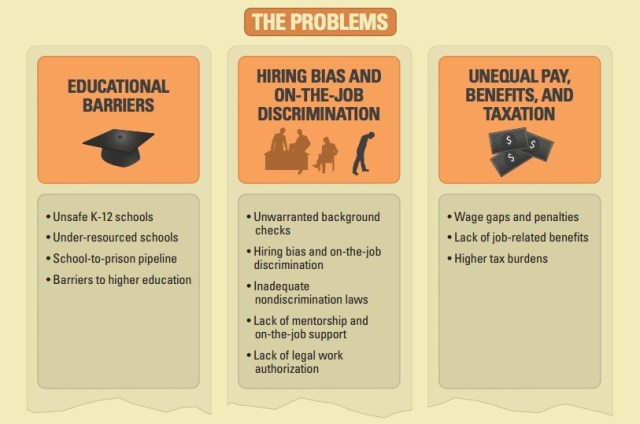
Our identities cannot be silo’ed, and neither can our oppression: if discrimination culminates in layers, their effects are similarly stacked. Let’s look at some findings:
+ Educational Barriers: LGBT youth often struggle to find safe and comfortable learning environments, whereas people of color typically struggle in underfunded public school programs. When you combine those, the effects can be disastrous, and even when you don’t, the challenges culminate in similar ways: kids stop going to school or start acting out and feed into the school-to-prison pipeline. If LGBT people of color make it to high school graduation without a record, they then face financial and emotional barriers in pursuing higher education, including dysfunctional or broken relationships with their families and poor performance or skill development that inhibits their acceptance or success further into the process.
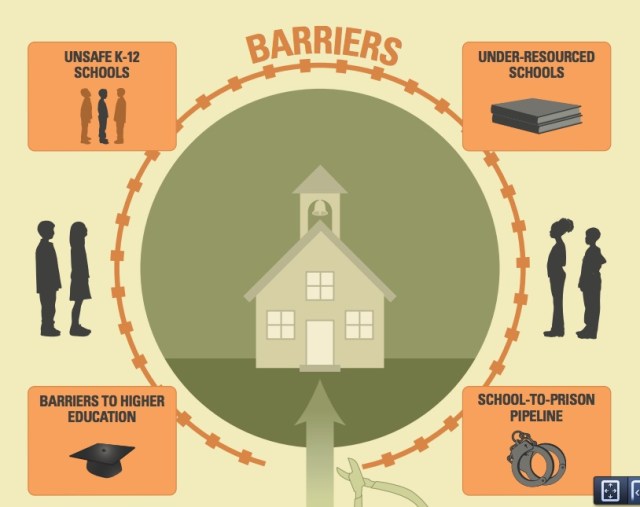
According to the report:
- The top concerns of LGBT youth are non-accepting families, bullying, and coming out. (For non-LGBT youth, top concerns include classes, grades, and planning for the future.)
- Students of color comprise 75% of enrollment at the lowest performing high schools in the country.
- 79% of LGBT youth of color indicate interactions with security or law enforcement officials.
+ Hiring and On-The-Job Discrimination: Barriers to employment are the first in a series of workplace-related challenges for LGBT people of color. Some may not have a lot of options – some folks may not have legal work verification, some may be eliminated from their pursuit of a dream job by their criminal record, some may suffer during employer credit checks, and others may not even be considered for a job based on their sex, race, or gender identity. Once they arrive, they may find hostile or discriminatory work environments, feel isolated and lose passion due to a lack of role models or mentors in their organization or industry, and face substantial barriers to filing complaints about the whole mess. (Folks who file intersectional complaints about discrimination are only half as likely to win those cases, too, even after it all.)
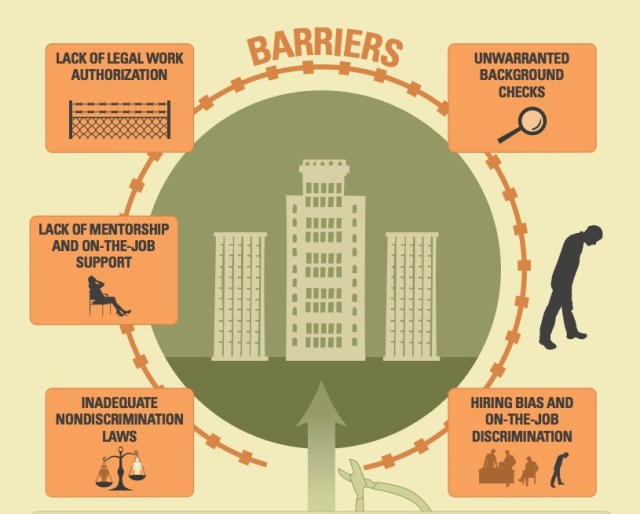
According to the report:
- In one study, identitical applicants with “white-sounding names” were 50% more likely to receive callbacks for job applications, and white candidates were interrupted less in their interviews. Workers of color were also more likely to have their experience checked.
- As many as 17% of LGB people report being unfairly denied employment or fired because of their orientation. 26% of trans* workers have been fired because of their status.
- Only 17 states and the District of Columbia have non-discrimination clauses inclusive of trans* and gender non-conforming folks, while 21 states and the District prohibit discrimination based on sexual orientation. 87% of Americans believe it is already illegal to fire someone for being LGBT.
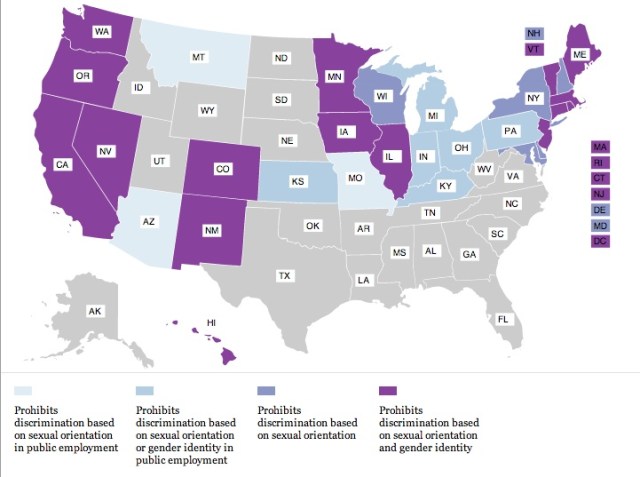
+ Unequal Pay / Benefits / Taxation: Even after overcoming the seemingly impossible task of graduating, completing college, and landing a job, the inequalities persist. For queer women of color, news of a “wage gap” isn’t new — but it is worse. Workers of color make less on-the-job than white people, and studies have shown that there is likely a wage penalty for being LGBT at work.
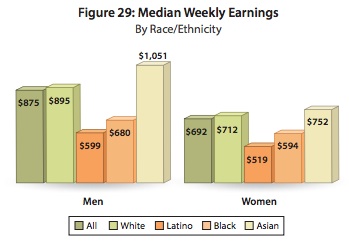
For most workers of color, these jobs aren’t your standard white-collar desk situations: people of color are less likely to earn a family-supporting wage or work in full-time jobs with benefits. And again, even if they do, the inequality persists: because LGBT family structures are often either unrecognized by law or made up of non-biological children, LGBT workers face unfair taxation and insurance costs. A lack of econmic material combined with low-wage jobs without leave or with hourly salaries causes LGBT workers of color, often, to ignore their health and overlook preventitve care – and, in some cases, they also won’t be offered coverage for services related to transition that they may need for their well-being. After a lifetime of trucking through these positions, many LGBT workers will find themselves elderly and without pensions or money for the future.
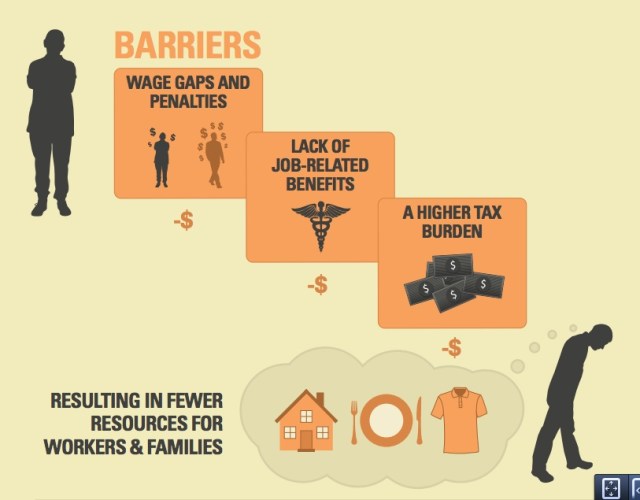
According to the report:
- 60% of American employers sponsor self-insured health plans, and are not required to offer benefits to same-sex spouses of employees.
- For every two workers of color who took leave in 2012, another needed it but couldn’t afford it.
- 20% of older adults who are black or Latino are considered poor.
But that’s not all. As they say in the Vagina Monologues: there are layers upon layers upon layers of intersectional challenges among those three areas of life. What if you’re in the closet at work because of a lack of protections or a hostile work environment? If it’s legal for your supervisor to fire you for being gay, you’re probably not going to use the rights bestowed on you by your cushy office job for paid family leave to care for your sick partner even though you’re entitled to. If you’re not out as trans* at work, you can’t take advantage of your LGBT-friendly health plan for transition-related appointments. And if you’re an immigrant working a low-wage job without a college degree, in many cases you’re not even entitled to paid leave or health care in the first place.
It’s easy to see how intersectionality could cause other forms of isolation and inequity as well: imagine yourself in a workplace where you’re the only queer person, and then add to it “of color.” Imagine, instead, that your workplace is incredibly gay-friendly or trans-friendly, but predominately white. Imagine that there is no professional space in which you feel actually understood, welcomed, or respected.
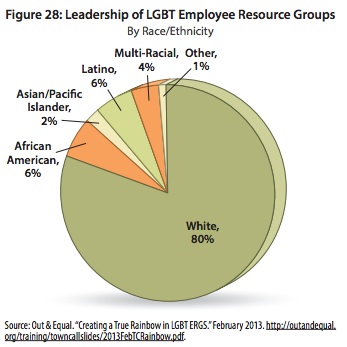 Now challenge yourself to imagine even thicker and more inescapable layers: for example, picture a young trans* kid who gets kicked out of the house when she comes out. Her parents aren’t caring for her, and aren’t going to support her education (most likely). Without them, she’s not just down college funds – she’s stuck searching for survival mechanisms. She’ll likely drop out of high school and could end up in prison or engaging in high-risk behaviors (which inevitably can take her to prison). Or imagine a young queer woman of color who was raised in a middle-class family and enjoyed a good education. She’s passionate, creative, and intelligent — but she has a super ethnic name and a (natural and) alternative lifestyle haircut. Even though she’s more skilled than her colleagues, she may not make it through the job hiring process based on any of these factors — and if she does, she may experience sexual harassment and suffer from anti-gay, racist, or sex-based wage discrimination (or a combination of the three).
Now challenge yourself to imagine even thicker and more inescapable layers: for example, picture a young trans* kid who gets kicked out of the house when she comes out. Her parents aren’t caring for her, and aren’t going to support her education (most likely). Without them, she’s not just down college funds – she’s stuck searching for survival mechanisms. She’ll likely drop out of high school and could end up in prison or engaging in high-risk behaviors (which inevitably can take her to prison). Or imagine a young queer woman of color who was raised in a middle-class family and enjoyed a good education. She’s passionate, creative, and intelligent — but she has a super ethnic name and a (natural and) alternative lifestyle haircut. Even though she’s more skilled than her colleagues, she may not make it through the job hiring process based on any of these factors — and if she does, she may experience sexual harassment and suffer from anti-gay, racist, or sex-based wage discrimination (or a combination of the three).
Can you identify a single solution to these forms of discrimination? Can you even identify a single systemic barrier which, if relieved, would have helped them all?
“Legislation and proposed solutions to discrimination often assume that the actions in question occur within a vacuum, but it never does.”
Throughout the report, space and entire pages are devoted to solutions to this myriad of challenges for LGBT workers of color attempting to support themselves and their loved ones. But that strikes me as just the problem — and it’s the reason these problems persist. Legislation and proposed solutions to discrimination often assume that the actions in question occur within a vacuum, but it never does. If a Latina lesbian is sexually harassed at work, or paid less than her straight, white, male peers, how can we isolate the cause and effect in order to eliminate both? If a black trans* woman is assaulted in her neighborhood, how can we deduce whether it was her trans* identity, her gender identity, or her perceived sex or race which “caused” it? The idea that solutions come down to one target is simplistic and going to fail.

“Just having information on how discrimination based on race, sex, and gender identity intersect to impact the lives of queer women of color is a benefit, because their experiences are often invisible to policymakers,” Gaylynn Burroughs, Director of Policy and Research at the Feminist Majority Foundation, said about the report. “But intersectional problems require intersectional solutions – and that demands that different groups work together to empower each other and ensure that equality reaches us all.”
“Those who work on the frontlines of workers’ rights now must take an intersectional approach to the work and make the leadership development of queer people of color a priority or else those workers that are most vulnerable to discrimination will continue to get left behind.”
Hooks echoed the sentiment when I asked her about the report. “Social movements must work to change anti-discrimination laws and find ways to shift the culture of the workplace,” she said.”Those who work on the frontlines of workers’ rights now must take an intersectional approach to the work and make the leadership development of queer people of color a priority or else those workers that are most vulnerable to discrimination will continue to get left behind.”
Mitchum, however, is confident that findings like those in this report will influence activists and lawmakers to do just that. “A simple look at the list of partners and coauthors on this report is evidence of the opportunity and the need for intersectional approaches — involving progressive organizations, labor, LGBT organizations, and civil rights organizations is a path to help ensure that all workers have the opportunity to obtain economic security through good jobs, regardless of race, ethnicity, sexual orientation, or gender identity and expression,” he said. “It is not simply about addressing the problem for queer people, or addressing it for people of color, but it is fundamentally about thinking more broadly about who is affected by a certain law and policy, and how you can create an all-encompassing solution.”
Word.

